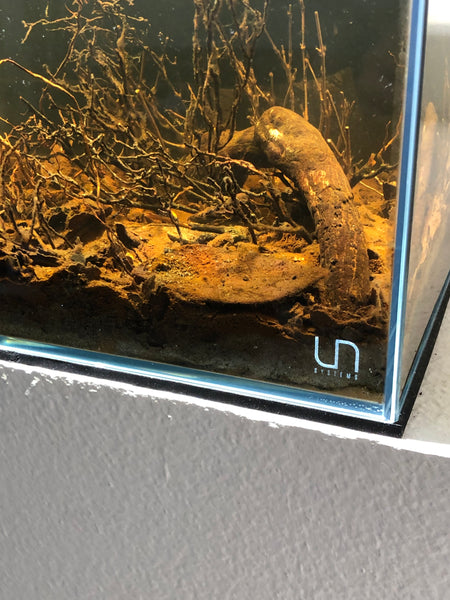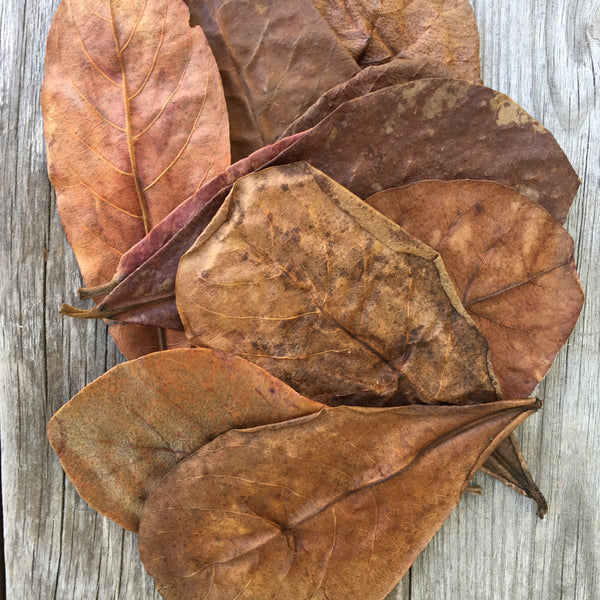- Continue Shopping
- Your Cart is Empty
On the idea of "leaf pulsing" and other environmental nuances...
As we all know, the basis of many of our blackwater, botanical-style systems is...wait for it- LEAVES! They make up a huge percentage of the plant materials which accumulate in tropical streams and other bodies of water in these locales, and, as we know, are extremely important to the fishes which inhabit them, providing protection, food, and even physical territory.

What makes leaves fall off the trees in the first place? Well, it's simple- er, rather complex...but I suppose it's simple, too. Essentially, the tree "commands" leaves to fall off the tree, by creating specialized cells which appear where the leaf stem of the leaves meet the branches. Known as "abscission" cells. for word junkies, they actually have the same Latin root as the word "scissors", which, of course, implies that these cells are designed to make a cut!
And, in the tropical species of trees, the leaf drop is important to the surrounding environment. The nutrients are typically bound up in the leaves, so a regular release of leaves by the trees helps replenish the minerals and nutrients which are typically depleted from eons of leaching into the surrounding forests.
And the rapid nutrient depletion, by the way, is why it's not healthy to burn tropical forests- the release of nutrients as a result of fire is so rapid, that the habitat cannot process it, and in essence, the nutrients are lost forever.

Now, interestingly enough, most tropical forest trees are classified as "evergreens", and don't have a specific seasonal leaf drop like the "deciduous" trees than many of us are more familiar with do...Rather, they replace their leaves gradually throughout the year as the leaves age and subsequently fall off the trees.
The implication here?
There is a more-or-less continuous "supply" of leaves falling off into the jungles and waterways in these habitats, which is why you'll see leaves at varying stages of decomposition in tropical streams. It's also why leaf litter banks may be almost "permanent" structures within some of these bodies of water!

And, for the fishes and other organisms which live in, around, and above the litter beds, there is a lot of potential food, which does vary somewhat between the "wet" and "dry" seasons and their accompanying water levels. The fishes tend to utilize the abundant mud, detritus, and epiphytic materials which accumulate in the leaf litter as food. During the dry seasons, when water levels are lower, this organic layer compensates for the shortage in other food resources.
During the higher water periods, there is a much greater amount of allochthonous input (remember that? I mean, on what other hobby-related site do you learn about THAT shit, huh?) from the surrounding terrestrial environment in the form of insects, fruits, and other plant material. I suppose that, in our aquariums, it's pretty much always the "wet season", right?
We tend to top off and replace decomposing leaves and botanical more-or-less continuously.

And it makes me wonder...
What if we stopped replacing leaves and even lowered water levels or decreased water exchanges in our tanks to correspond to, for example, the Amazonian dry season (June to December)...And if you consider that many fishes tend to spawn in the "dry" season, concentrating in the shallow waters, could this have implications for breeding?

In fact, I further proffer that we need to look a lot deeper into the idea of environmental manipulation for the purpose of getting our fishes to be healthier, more colorful, and especially, to spawn. Now I know, the idea is nothing new on a "macro" level- we've been increasing and lowering temps in our aquariums, adjusting lighting levels, and tweaking stuff for a long time.

Killie keepers have played with this in drying and incubation periods in annual killifish eggs. However, I don't think we've been doing a lot of real hardcore manipulations...like adjusting water levels, increasing nutrient levels (ie; "pulsing" adding leaves and other botanicals), manipulating current, dissolved oxygen, food types, etc.

I think that there are so many different things that we can play with- and so many nuances that we can investigate and manipulate in our aquariums. What about the pulsing of leaf additions to correspond to the seasonal leaf drop?

I think that this could even add a new nuance to biotope aquarium simulation, such as creating an aquarium which simulates the "Preto da Eva River in Brazil in October", for example...with appropriate environmental conditions, such as water level, amounts of allochthonous material, etc. Show those hardcore contest biotope snobs what a real biotope aquarium is all about!
The possibilities are endless here!

So much to consider.
We don't embrace the aesthetic of dark water, a bottom covered in decomposing leaves, and the appearance of biofilms and algae on driftwood because it allows us to be more "relaxed" in the care of our tanks, or because we think we're so much smarter than the underwater-diorama-loving, hype-mongering competition aquascaping crowd, either-something that's occasionally been levied against our community.
(Well, maybe we are? 😆)
I mean, we're doing this stuff for a reason: To create more authentic-looking, natural-functioning aquatic displays for our fishes. To understand and acknowledge that our fishes and their very existence is influenced by the habitats in which they have evolved.
Wild tropical aquatic habitats are influenced greatly by the surrounding geography and flora of their region, which in turn, have considerable influence upon the population of fishes which inhabit them, and their life cycle. The simple fact of the matter is, when we add botanical materials to an aquarium and accept what occurs as a result-regardless of wether our intent is just to create a different aesthetic, or perhaps something more- we are to a very real extent replicating the processes and influences that occur in wild aquatic habitats in nature.
The presence of botanical materials such as leaves in these aquatic habitats is fundamental.

In our little hobby sector, leaves are sort of the "gateway drug", if you will, into our world.

In Nature, as we've discussed many times-leaf litter zones comprise one of the richest and most diverse biotopes in the tropical aquatic ecosystem, yet until recently, they have seldom been replicated in the aquarium. I think this has been due, in large part- to the lack of continuous availability of products for the hobbyist to work with, and a lack of real understanding about what this biotope is all about- not to mention, the understanding of the practicality of creating one in the aquarium.

Long-held fears and concerns, such as overwhelming our systems with biological materials, and the overall "look" of decomposing leaves and botanicals in our tanks, have understandably led to this idea being relegated to "sideshow status" for many years. It's only been recently that we've started looking at them more objectively as ecological niches worth replicating in aquariums.
The thought behind this habitat can best be summarized in this interesting except from an academic paper on Amazonian Blackwater leaf-litter communities by biologist Peter Alan Henderson, one that is useful for those of us attempting to replicate these communities in our aquaria:
"..life within the litter is not a crowded, chaotic scramble for space and food. Each species occupies a sub-region defined by physical variables such as flow and oxygen content, water depth, litter depth and particle size…
...this subtle subdivision of space is the key to understanding the maintenance of diversity. While subdivision of time is also evident with, for example, gymnotids hunting by night and cichlids hunting by day, this is only possible when each species has its space within which to hide.”
In other words, different species inhabit different sections of the leaf litter bed, and we should consider this when creating and stocking our biotope systems...
The implication for aquariums is that we could literally create a diverse fish community by embracing a deep leaf litter bed as the "theme" of the aquarium. This is really neat stuff, and we're just scratching the surface here!

So, beyond just creating an aggregation of material which imparts tannins and humic substances into the water in our tanks, we're creating a little habitat, every bit as interesting, diverse, and complex as any other we attempt to replicate. In the aquarium, you need to consider both practicality AND aesthetics when replicating this biotope.
A biotope that deserves your attention and study, indeed.

Obviously, there is still much to learn, and of course, the bigger question that many will ask, "What is the advantage?"
That's part of the fun...we can play a hunch, but we won't know for certain until we really delve into this.
Who's in?
Stay thoughtful. Stay curious. Stay engaged. Stay innovative...
And Stay Wet.
Scott Fellman
Tannin Aquatics








Scott Fellman
Author